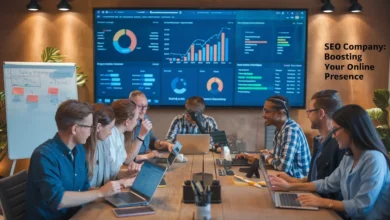Have you ever wondered why some websites always seem to land on the first page of Google, while others struggle to be seen? 🤔 The secret lies in understanding and mastering Google’s ranking algorithm – a complex system that determines which pages appear at the top of search results. For businesses and content creators alike, cracking this code can mean the difference between online obscurity and digital success.
In today’s fast-paced digital landscape, staying ahead of the SEO game is crucial. With Google’s algorithm constantly evolving, it’s easy to feel left behind. But fear not! Our comprehensive guide, “Unlock Google’s Ranking Algorithm: Exciting New Secrets,” is here to demystify the process and equip you with proven strategies to elevate your online presence. From keyword mastery to technical optimization, we’ll explore the key factors that influence your rankings and provide actionable tips to help you climb the search engine ladder.
Ready to transform your SEO approach and skyrocket your website’s visibility? 🚀 Join us as we dive into the intricacies of Google’s ranking algorithm, uncover the power of high-quality content, and reveal the technical tricks that can give you a competitive edge. Whether you’re a seasoned marketer or just starting your SEO journey, this guide will arm you with the knowledge and tools you need to succeed in the ever-changing world of search engine optimization.
Understanding Google’s Ranking Algorithm

Core components: crawling, indexing, and ranking
Google’s ranking algorithm operates through three fundamental processes: crawling, indexing, and ranking. Crawling involves Google’s bots scanning the web to discover new and updated content. Indexing is the process of storing and organizing this content in Google’s vast database. Finally, ranking determines the order in which content appears in search results based on various factors.
Key ranking factors: backlinks, content quality, and user experience
Among the numerous factors Google considers, three stand out as particularly significant:
- Backlinks: Quality backlinks from reputable websites serve as votes of confidence, significantly influencing a page’s ranking. They account for 13% of the ranking factors in the 2025 algorithm.
- Content Quality: The consistent publication of satisfying content remains the most crucial factor, contributing 23% to the ranking algorithm. Google prioritizes high-quality, informative, and relevant content that meets searchers’ intent.
- User Experience: This encompasses various elements, including mobile-friendliness (5%), page speed (3%), and overall searcher engagement (12%). A positive user experience is essential for higher rankings.
Historical updates: PageRank, Panda, and Penguin
Google’s algorithm has undergone significant changes over the years:
- PageRank: This early algorithm used the quantity and quality of links to a page to determine its importance.
- Panda: Introduced to combat low-quality content, this update focused on promoting high-quality, original content while penalizing thin or duplicate material.
- Penguin: This update targeted webspam and manipulative link-building practices, emphasizing the importance of natural, high-quality backlinks.
These updates have shaped Google’s current approach, which prioritizes content quality, user engagement, and trustworthiness over traditional SEO tactics like keyword stuffing or manipulative link-building.
Now that we have covered the fundamentals of Google’s ranking algorithm, we’ll explore how to master keyword strategy for SEO success in the next section.
Mastering Keyword Strategy for SEO Success

Now that we’ve explored how Google’s ranking algorithm works, let’s dive into mastering keyword strategy for SEO success. Understanding and implementing an effective keyword strategy is crucial for optimizing your content and improving your search engine rankings.
Conducting thorough keyword research
Keyword research is the foundation of a successful SEO strategy. It helps identify keywords that are both relevant and attainable for ranking, aligning your content creation with audience search behavior. To conduct thorough keyword research:
- Start by identifying relevant topics and potential keywords related to your niche.
- Use keyword research tools like Google Keyword Planner, Ubersuggest, or Moz Keyword Explorer to generate ideas and analyze search performance.
- Consider factors such as search volume, keyword difficulty, and relevance when selecting keywords.
- Understand user intent behind searches to craft content that meets their needs.
Targeting long-tail keywords for lower authority sites
For websites with lower authority, focusing on long-tail keywords can be an effective strategy:
- Long-tail keywords are more specific and typically consist of three or more words.
- They often have lower competition and higher relevance to user intent.
- Prioritize long-tail keywords for quicker wins against more competitive head terms.
- Use tools like Keyword Tool.io or KWFinder to discover lesser-known long-tail keywords.
Avoiding keyword cannibalization
Keyword cannibalization occurs when multiple pages on your site target the same keyword, potentially harming your SEO efforts:
- Carefully plan your content strategy to avoid targeting the same keywords across multiple pages.
- Use keyword clustering to group related keywords and streamline content creation.
- Regularly audit your existing content to identify and resolve any instances of keyword cannibalization.
Integrating related keywords and semantic terms
To enhance your keyword strategy and improve content relevance:
- Incorporate related keywords and semantic terms in your content.
- Use tools like SEMrush or Ahrefs Keywords Explorer to identify related terms and synonyms.
- Focus on creating comprehensive content that naturally includes these related terms.
- Consider location-specific keywords for local businesses to improve geographically relevant searches.
With a solid keyword strategy in place, you’re now ready to move on to crafting high-quality, relevant content that aligns with your chosen keywords and meets user intent.
Crafting High-Quality, Relevant Content

Now that we’ve covered the importance of mastering keyword strategy for SEO success, let’s delve into the critical aspect of crafting high-quality, relevant content that aligns with Google’s ranking algorithm.
Meeting user intent to reduce bounce rates
To effectively optimize content for search engines and attract traffic, it’s crucial to align your content with search intent. Analyze the top-ranking results for your target keywords to understand the content type, format, and angle that users expect. By meeting user expectations, you can reduce bounce rates and signal to Google that your content is valuable and relevant.
Creating comprehensive, original content
Comprehensive content that thoroughly addresses user queries tends to perform better in rankings. Aim to create longer articles that cover topics in-depth, providing unique insights and expert quotes. Conduct a content gap analysis against competitors to identify missing subtopics that could enhance your post’s depth and relevance. Remember to eliminate fluff, use short paragraphs, and include visuals to facilitate easy skimming.
Establishing topical authority through consistent publishing
Regular updates to existing content can yield significant benefits for your website’s SEO performance. By consistently publishing high-quality content on specific topics, you can establish topical authority in your niche. This approach not only helps in attracting thousands of monthly visitors but also signals to search engines that your website is a reliable source of information in your field.
Optimizing for featured snippets
To enhance visibility in search results, optimize your content for featured snippets. Structure your content to directly answer common queries related to your topic. Use clear headings, bullet points, and concise paragraphs to increase your chances of being selected for these prominent SERP features. Additionally, implement structured data markup to make your content more eligible for rich snippets, further boosting your visibility in search results.
With these content creation strategies in mind, we’ll next explore the technical SEO optimization techniques that can further enhance your website’s performance in search engine rankings.
Technical SEO Optimization Techniques

Now that we’ve covered the importance of crafting high-quality, relevant content, let’s delve into the technical aspects of SEO optimization. These techniques are crucial for ensuring that your well-crafted content can be easily discovered and indexed by search engines.
Improving site speed and mobile responsiveness
Site speed and mobile responsiveness are critical factors in Google’s ranking algorithm. To enhance your website’s performance:
- Optimize page load times by reducing file sizes and eliminating unnecessary scripts
- Implement a responsive design that adapts to various screen sizes
- Utilize tools like Google’s PageSpeed Insights to identify and address performance issues
Implementing SSL encryption for security
HTTPS security is not just a best practice; it’s a ranking factor. To secure your website:
- Obtain and install an SSL certificate
- Ensure all internal links and resources use HTTPS
- Set up proper redirects from HTTP to HTTPS versions of your pages
Utilizing structured data and SEO plugins
Structured data helps search engines better understand your content:
- Implement schema markup to provide context for your content
- Use SEO plugins to simplify the process of adding structured data
- Regularly audit your structured data implementation using tools like Google’s Structured Data Testing Tool
Optimizing URLs, headers, and meta descriptions
These elements play a crucial role in how search engines interpret and display your content:
- Create concise, descriptive URLs that include relevant keywords
- Use header tags (H1, H2, etc.) to structure your content logically
- Craft compelling meta descriptions that accurately summarize page content and encourage clicks
By implementing these technical SEO optimization techniques, you’ll create a solid foundation for your website’s performance in search rankings. With your technical elements in place, the next step is to focus on building a strong backlink profile, which we’ll explore in the following section.
Building a Strong Backlink Profile

Now that we’ve covered technical SEO optimization techniques, let’s delve into another crucial aspect of improving your Google rankings: building a strong backlink profile.
Acquiring topically relevant backlinks
To boost your website’s authority, focus on obtaining backlinks from authoritative news sites and blogs within your industry. Utilize services like Help a B2B Writer and Featured.com to connect with journalists seeking sources. Create “Skyscraper” content by improving upon popular topics and actively promoting it to those mentioned within. Additionally, employ “The Moving Man Method” by identifying outdated resources and reaching out to sites linking to defunct content, offering your own as a replacement.
Focusing on quality over quantity
When it comes to backlinks, prioritize quality over quantity. High-quality backlinks from reputable websites with high domain authority significantly enhance your chances of achieving higher rankings. Avoid low-quality links from spammy directories or link farms, as these can trigger penalties under Google’s Penguin algorithm. Regularly audit your backlink profile using tools like Google Search Console to identify and mitigate toxic links.
Leveraging social media for visibility
Utilize social media platforms to amplify your reach and generate backlinks. Share your content across various channels to increase exposure and encourage others to link to your site. Engage with influencers and build relationships to leverage their networks for additional backlinks. Creating expert roundups and fostering connections with industry peers can also lead to valuable backlink opportunities.
Creating local citations for local SEO
For businesses targeting local markets, focus on creating local citations to enhance your local SEO efforts. Utilize data aggregators to ensure your business is listed across various directories. This strategy not only improves your visibility in local search results but also contributes to building a strong backlink profile.
With a robust backlink strategy in place, we’ll next explore how enhancing user experience can further improve your Google rankings.
Enhancing User Experience for Better Rankings

Now that we’ve covered the importance of building a strong backlink profile, let’s explore how enhancing user experience can significantly boost your rankings in Google’s search results.
Simplifying website navigation
A well-structured site architecture is crucial for both users and search engines. By creating intuitive navigation, you can help visitors find information quickly and easily. This not only improves user satisfaction but also aids search engines in crawling and indexing your content more effectively. Consider implementing clear menus, logical page hierarchies, and internal linking to guide users through your site seamlessly.
Minimizing intrusive elements
Google’s algorithms take into account the presence of intrusive elements that can negatively impact user experience. To improve your rankings, minimize the use of pop-ups, interstitials, and excessive ads that may disrupt the user’s journey through your site. Focus on delivering valuable content without unnecessary distractions, ensuring a smooth and enjoyable browsing experience for your visitors.
Optimizing for mobile-first indexing
With the growing number of users accessing the internet via mobile devices, Google has shifted to mobile-first indexing. This means that the mobile version of your website is now prioritized for indexing and ranking. Ensure that your mobile pages mirror the quality and content of your desktop pages, providing a consistent experience across all devices. Implement responsive design techniques to adapt your site’s layout and functionality to various screen sizes.
Improving page load times
Page speed is a critical factor in both user experience and SEO. Slow-loading sites negatively impact user engagement and conversions, leading to higher bounce rates and lower rankings. To optimize your page load times:
- Compress images and use appropriate file formats
- Minimize unnecessary CSS and JavaScript
- Implement lazy loading for images and videos
- Utilize browser caching
By focusing on these aspects of user experience, you can create a website that not only satisfies your visitors but also aligns with Google’s ranking factors. Remember that a positive user experience leads to longer site visits, lower bounce rates, and ultimately, better search engine performance.
As we move forward, we’ll explore the importance of continuous monitoring and optimization to ensure your SEO efforts remain effective in the ever-changing landscape of search engine algorithms.
Continuous Monitoring and Optimization

Now that we’ve explored the importance of enhancing user experience for better rankings, let’s dive into the crucial aspect of continuous monitoring and optimization to maintain and improve your SEO efforts.
Tracking key metrics with analytics tools
To effectively monitor your SEO performance, it’s essential to utilize powerful analytics tools. Google Analytics 4 stands out as a free option that provides real-time insights into user behavior and helps identify top-performing content. For more comprehensive tracking, consider paid tools like Semrush, SE Ranking, or Ahrefs. These platforms offer features such as keyword tracking, competitor analysis, and custom reporting to help you stay on top of your SEO game.
Updating content regularly for freshness
Keeping your content fresh and up-to-date is crucial for maintaining strong search engine rankings. Regularly review and update your existing content to ensure it remains relevant and accurate. This practice not only helps with SEO but also provides value to your audience, encouraging return visits and improving user engagement metrics.
Adapting to algorithm updates
Google’s ranking algorithm is constantly evolving, and staying informed about these changes is vital for SEO success. Keep an eye on industry news and official Google announcements to understand new ranking factors or shifts in priorities. Tools like Moz and Ahrefs often provide insights into algorithm updates, helping you adapt your strategies accordingly.
A/B testing for performance improvements
Implement A/B testing to refine your SEO strategies and improve overall performance. This involves creating variations of your content, meta tags, or page layouts to determine which versions perform better in terms of rankings and user engagement. Use tools like Google Search Console to monitor the impact of these changes on your search performance and make data-driven decisions for optimization.
By consistently applying these monitoring and optimization techniques, you’ll be better equipped to maintain and improve your website’s search engine rankings over time. Remember, SEO is an ongoing process that requires dedication and adaptability to achieve long-term success.
Frequently Asked Questions (FAQs)

How often does Google update its ranking algorithm?
Google continuously updates its ranking algorithm, with minor changes occurring almost daily. However, major updates, known as “core updates,” typically happen several times a year. These core updates can significantly impact search results and website rankings. It’s essential for website owners and SEO professionals to stay informed about these updates and adapt their strategies accordingly.
Can I improve my rankings quickly by buying backlinks?
While backlinks are an important factor in Google’s ranking algorithm, buying backlinks is strongly discouraged and can lead to penalties. Google’s algorithm is designed to detect and penalize artificial link-building practices. Instead, focus on creating high-quality content that naturally attracts backlinks from reputable sources. This organic approach aligns with Google’s guidelines and provides long-term SEO benefits.
How long does it take to see results from SEO efforts?
The timeline for seeing SEO results can vary depending on various factors, including your website’s current standing, competition, and the extent of your optimization efforts. Generally, it takes 3-6 months to start seeing noticeable improvements in rankings and organic traffic. However, SEO is an ongoing process, and continuous efforts are required to maintain and improve your position in search results over time.
Is social media activity a direct ranking factor?
While social media activity is not a direct ranking factor in Google’s algorithm, it can indirectly influence your SEO performance. Social media engagement can increase brand visibility, drive traffic to your website, and potentially lead to more backlinks. These factors can contribute to improved rankings over time. Additionally, social signals may indirectly influence Google’s perception of your website’s authority and relevance.
Conclusion

Google’s ranking algorithm is a complex and ever-evolving system that requires a multifaceted approach to SEO. By understanding its core components and implementing proven strategies, you can significantly improve your website’s visibility and organic traffic. From mastering keyword research and creating high-quality content to optimizing technical aspects and building a strong backlink profile, each element plays a crucial role in your SEO success.
Remember that SEO is an ongoing process that demands continuous monitoring and adaptation. Stay informed about algorithm updates, regularly analyze your website’s performance, and be prepared to refine your strategies as needed. By focusing on providing value to your users while adhering to SEO best practices, you’ll be well-positioned to unlock the secrets of Google’s ranking algorithm and achieve long-term success in the competitive digital landscape.





